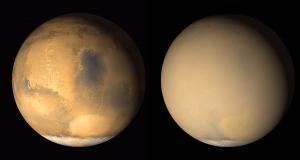Dust storms can whip up in a hurry on Mars, with the biggest of them covering the entire planet. These two images, for example, show the same view of Mars, but taken just one month apart. In the image on the left, the skies are clear; at right, a global dust storm has hidden most of the planet's features from view. A big dust storm could swirl to life on Mars later this year. [NASA/JPL/MSSS]
You are here
Moon and Mars
Clouds are a common sight at this time of year, as thunderstorms erupt across much of the country. Big clouds also can darken the skies on Mars — clouds made not of water, but of dust. In fact, some Mars experts predict that a giant dust storm could develop later this year, and last for weeks or months.
There’s dust in the Martian atmosphere all the time. As much as half of it may be stirred up by dust devils — tall, whirling columns like those seen in deserts here on Earth. They can splash dust high into the atmosphere, where it may circulate around the entire planet.
Mars also produces dust storms. Most of them are regional — they cover thousands of square miles, usually in the northern hemisphere. Their dust can remain in the sky for a long time, too. And every few years, a storm turns into a monster — it can cover most of the planet. That could happen later this year — a storm that could darken the skies across all of Mars.
As the dust swirls into the sky, it also carries water vapor. At high altitudes, sunlight splits the water molecules apart. The water’s lighter hydrogen atoms then may be blown out into space, slowly depleting the Martian atmosphere.
And Mars is easy to find early tomorrow. It stands to the right of the Moon at first light, and looks like a bright orange star — its surface colored by the same dust that dirties its sky. Saturn is close to the upper right of Mars, completing a beautiful display in the dawn sky.
Script by Damond Benningfield
Get Premium Audio
Listen to today's episode of StarDate on the web the same day it airs in high-quality streaming audio without any extra ads or announcements. Choose a $8 one-month pass, or listen every day for a year for just $30.







